One of my favorite hiking treats is fresh, fully ripened, prickly pear. Not the kind that you find in the grocery store that is still green but warm from the sun and juicier than you can imagine!
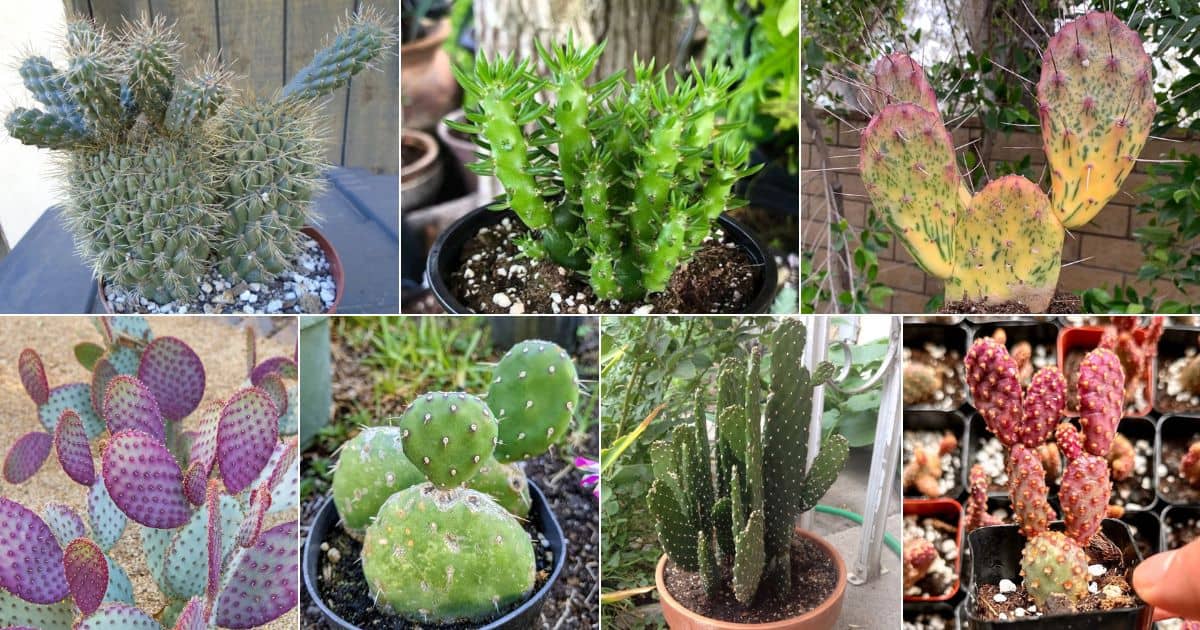
Opuntias are varied, and many of them have that wonderful fruit to snack on. From variegated variants to emerald green species, the types of Opuntia cacti are endless. Here you’ll find both dwarf cacti and tree cacti, as well as a few rarities!
Jump to:
- 1. Opuntia santa-rita
- 2. Opuntia ficus-indica
- 3. Bunny Ears Opuntia
- 4. Opuntia phaeacantha
- 5. Opuntia polyacantha v. erinacea
- 6. Opuntia monacantha ‘Maverick’ Variegata
- 7. Opuntia sulphurea
- 8. Opuntia erinacea ursine
- 9. Cinnamon Cactus
- 10. Opuntia engelmannii
- 11. Opuntia consolea rubescens
- 12. Opuntia subulata
- 13. Boxing Glove Opuntia
- 14. Red Buttons Opuntia
- 15. Opuntia falcata
- 16. Opuntia macrocentra
- 17. Aaron’s Beard Prickly Pear
- 18. Opuntia Amethyst Wave
- 19. Opuntia invicta
- 20. Opuntia cochenillifera variegata
1. Opuntia santa-rita
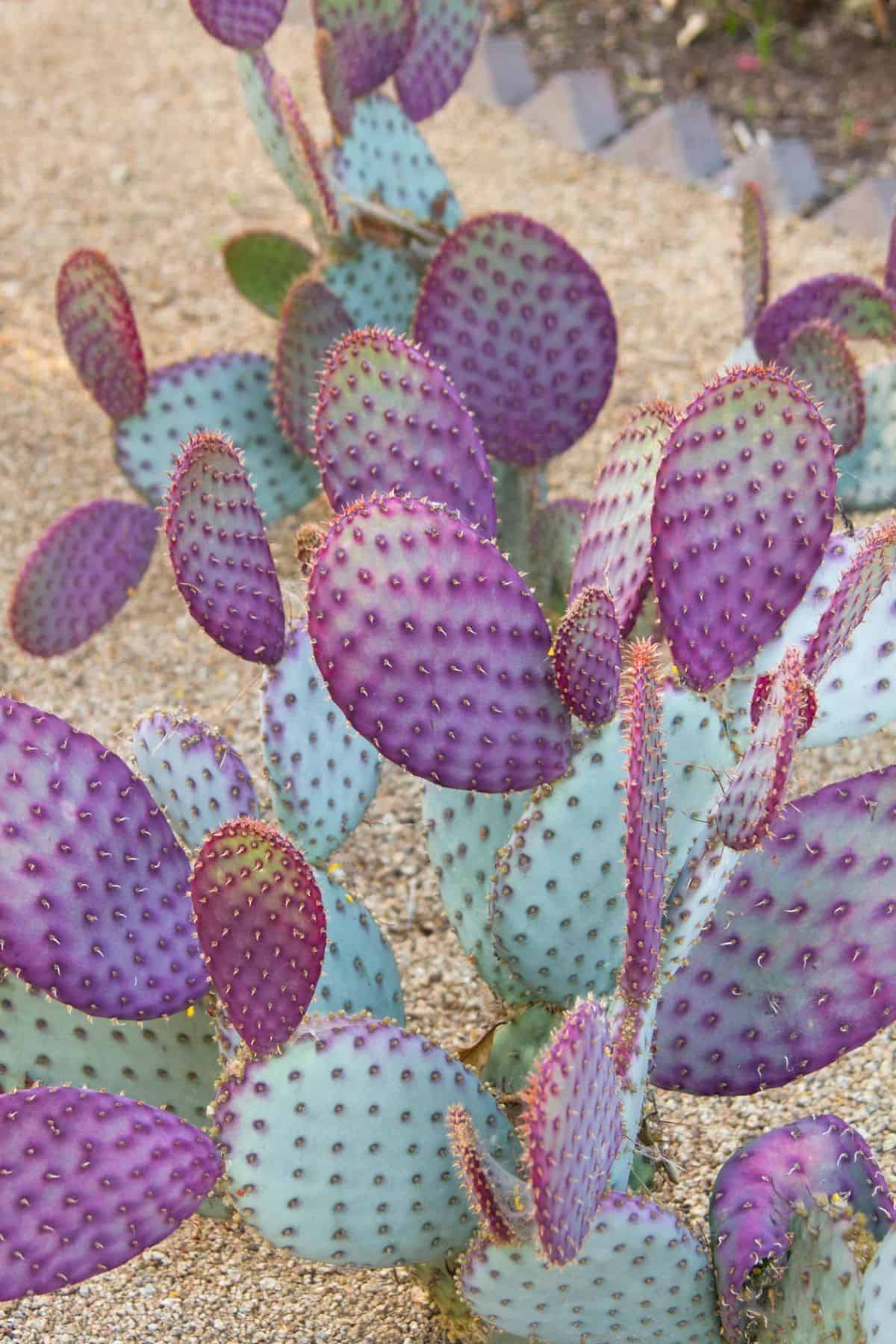
Buy it from:
| Maximum Height: | Up to 8 feet |
| Maximum Width: | Up to 10 feet |
| Watering Needs: | Supplemental water during the dry season when established; water bi-weekly until established. |
| Soil Needs: | Well-draining soil (preferably sandy) |
| Light Needs: | Full sun to partial shade |
| Hardiness Zone(s): | Zone 7 and up |
| Bloom Color: | Bright yellow |
| Leaf Type: | Round, turns more purple with more sun exposure |
| Spine Type: | Very short and all over the pad |
Santa Rita is a personal favorite because of how showy it is. Not only does it have almost perfectly circular pads, but the mottling of green and purple perfectly accents any garden. Like many prickly pears, the fruit is edible but watch out for spines on the fruit. Even though they are short, the spines can easily embed themselves!
2. Opuntia ficus-indica
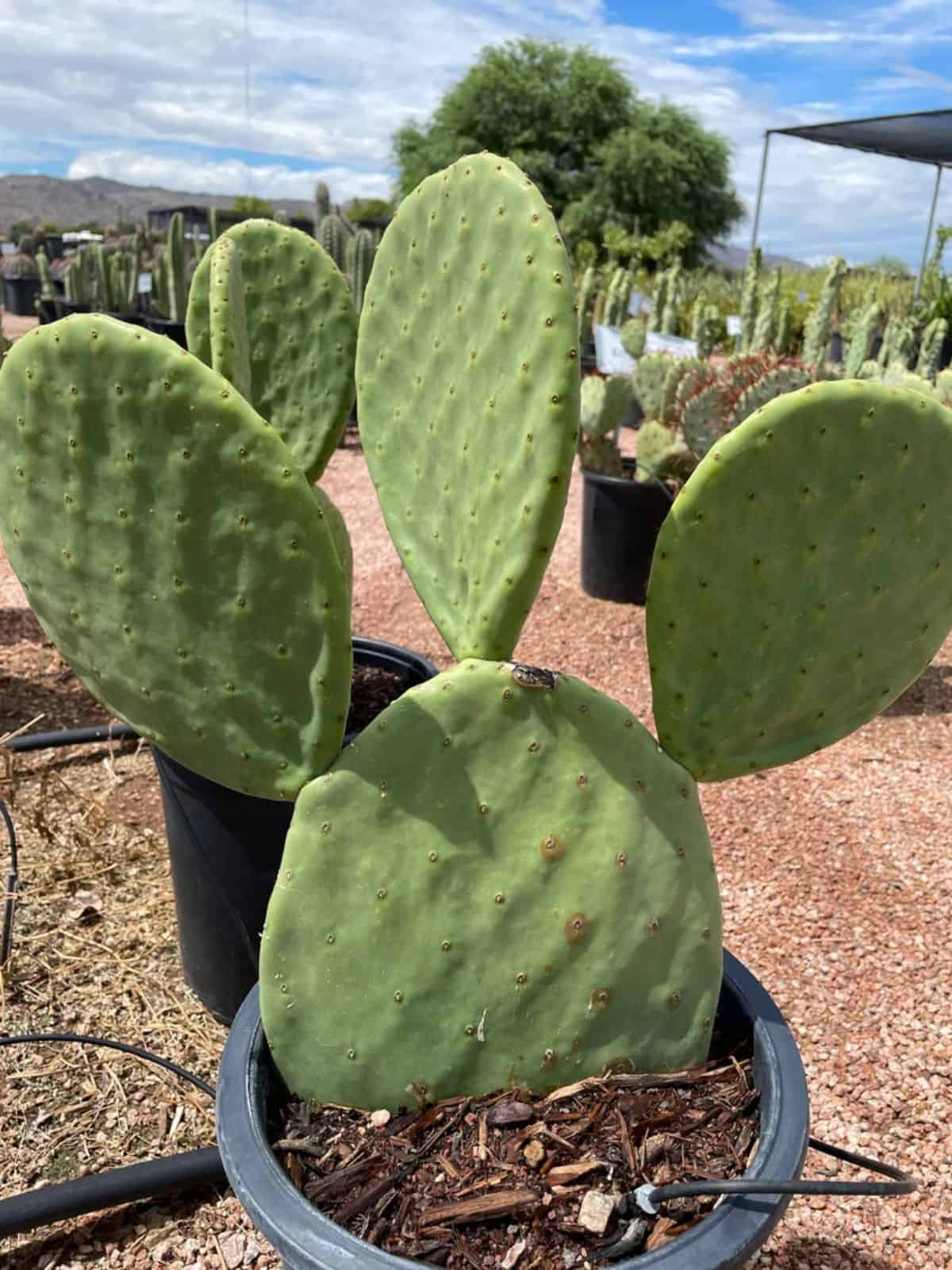
Buy it from:
| Maximum Height: | Up to 15 feet |
| Maximum Width: | Up to 10 feet |
| Watering Needs: | Supplemental water during the dry season when established; water bi-weekly until established. |
| Soil Needs: | Well-draining soil (preferably sandy) |
| Light Needs: | Full sun to partial shade |
| Hardiness Zone(s): | Zone 8 and up |
| Bloom Color: | Orange-red flowers |
| Leaf Type: | Large oval pads that can get up to 2 feet across |
| Spine Type: | 1 - 2 inches long, firm, no glochids |
One of the most prolific and common species found in many different areas is the O. ficus-indica. It is commonly referred to as the Prickly Pear … but so are many other opuntia species. Compared to others, this species’ most impressive element is how massive the pads can grow. Just think of comparing your forearm to the giant pads. It’s hard to imagine!
3. Bunny Ears Opuntia
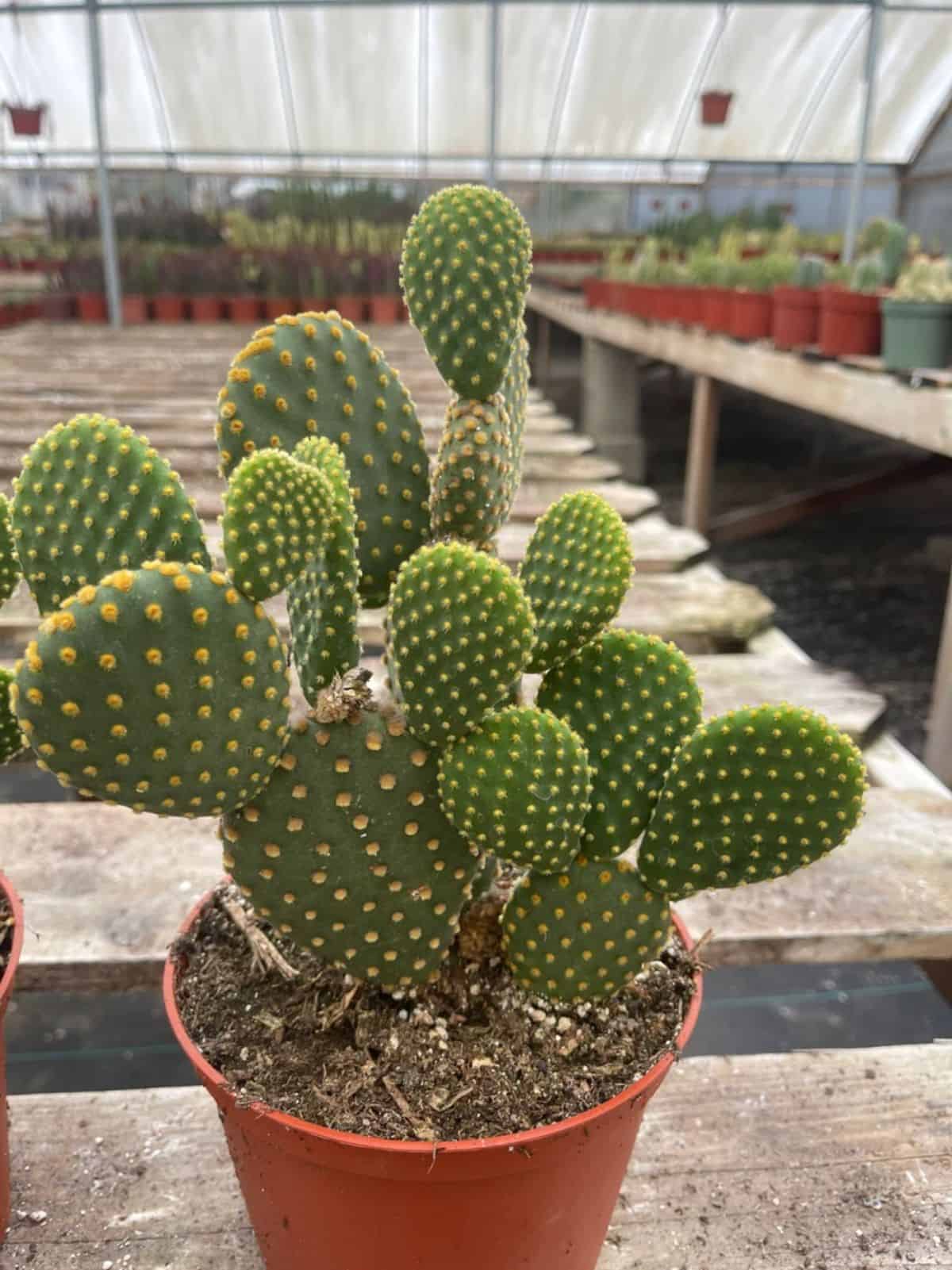
Buy it from:
| Maximum Height: | Up to 4 feet |
| Maximum Width: | Up to 5 feet |
| Watering Needs: | Supplemental water during the dry season when established; water bi-weekly until established. |
| Soil Needs: | Well-draining soil (preferably sandy) |
| Light Needs: | Full sun |
| Hardiness Zone(s): | Zone 8 and up |
| Bloom Color: | Yellow with a potential red tinge |
| Leaf Type: | Flattened paddles that appear two at a time |
| Spine Type: | Evenly distributed areoles with spines that grow as the cactus does. |
If you are looking for an adorable gift or something cute to add to your own collection, check out Opuntia microdasys. This tiny wonder only produces new leaves in pairs, which is where it gets the name Bunny Ears. The glochids that surround the areoles are also fluffy white which helps add the bunny aesthetic.
.
4. Opuntia phaeacantha
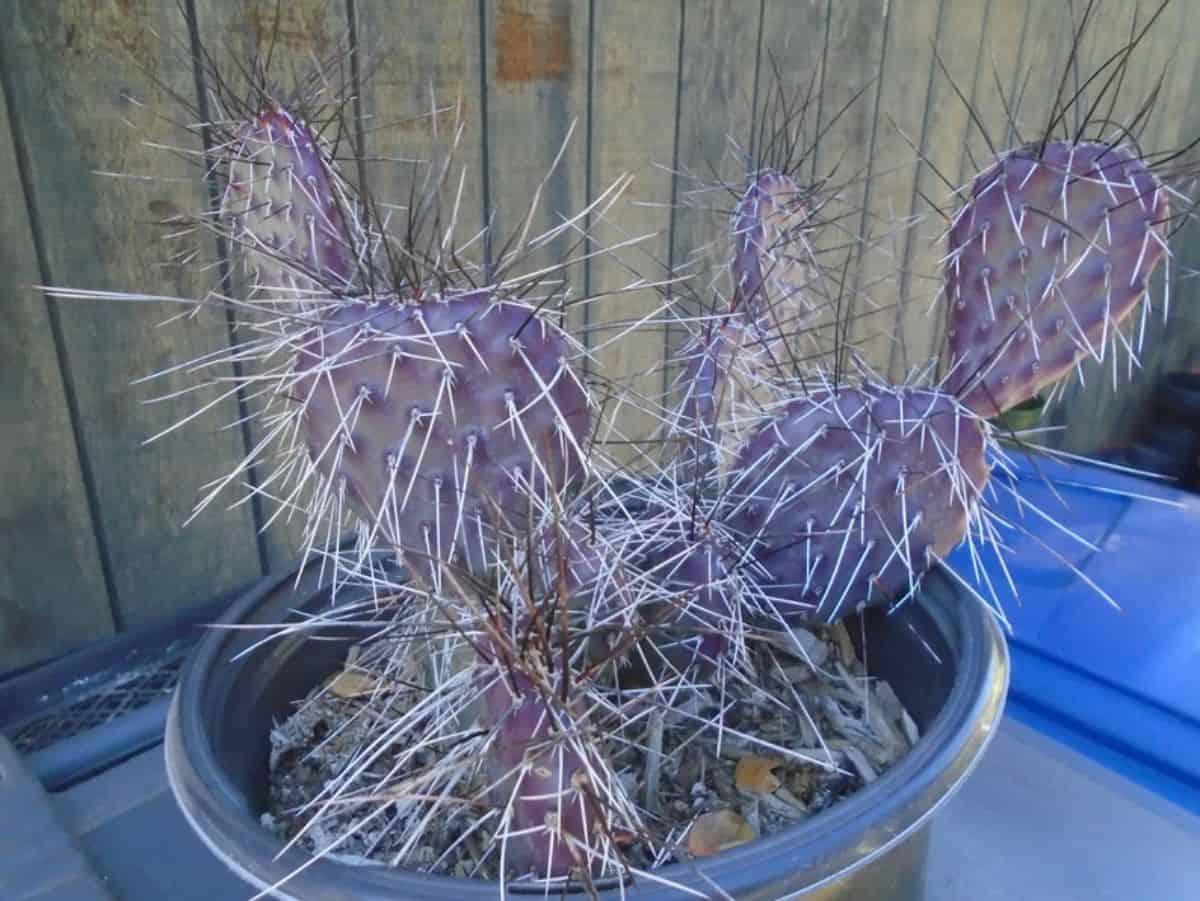
Buy it from:
| Maximum Height: | Up to 10 feet |
| Maximum Width: | Up to 2 feet |
| Watering Needs: | Supplemental water during the dry season when established; water bi-weekly until established. |
| Soil Needs: | Well-draining soil (preferably sandy) |
| Light Needs: | Full sun to partial shade |
| Hardiness Zone(s): | Zone 6 and up |
| Bloom Color: | Bright pink |
| Leaf Type: | Smaller paddles that turn maroon as they age |
| Spine Type: | Gray thorns that are several inches long |
The Dark Knight, or Tulip Prickly Pear, is an interesting specimen to collect. It’s one of three to four species that turn a more purple color when under stress or as they grow. Dark Knight gets its name not only from the color of the pads but also because the thorns are gray rather than a light sandy color like most opuntias.
5. Opuntia polyacantha v. erinacea
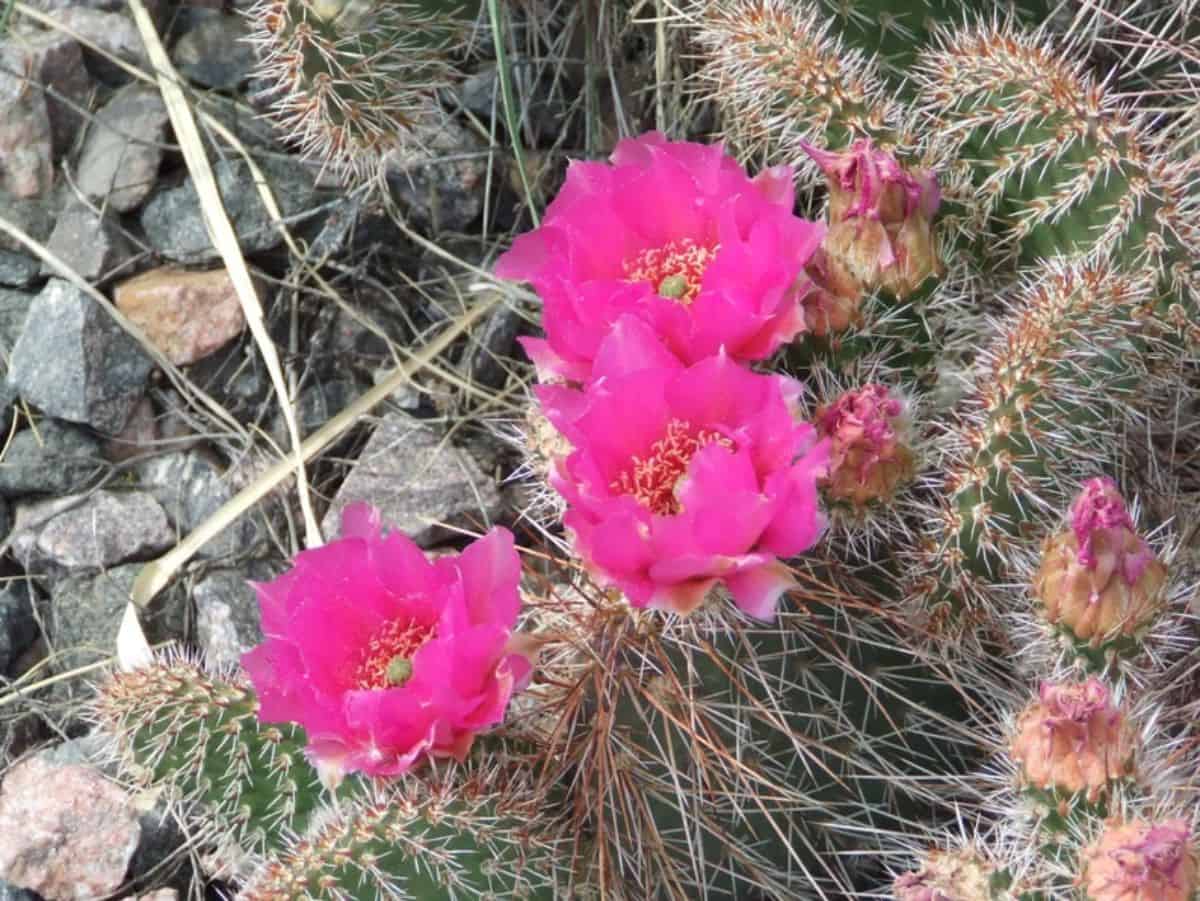
Buy it from:
| Maximum Height: | Up to 1 foot |
| Maximum Width: | Up to 3 feet |
| Watering Needs: | Supplemental water during the dry season when established; water bi-weekly until established. |
| Soil Needs: | Well-draining soil (preferably sandy) |
| Light Needs: | Full sun to partial shade |
| Hardiness Zone(s): | Zone 7 and up |
| Bloom Color: | Dark red-pink or yellow |
| Leaf Type: | Roughly 5-inch by 3-inch pads |
| Spine Type: | Four-inch flexible/flowing spines |
Also known as the Grizzly Bear cactus, this tiny but tough cactus is easy to grow and loved for its bright flowers. More mature species can have spines that are long enough and profuse enough that they cover the pads like grizzly bear fur. While it isn’t the only bear-named species, it is the only one with dark brown spines.
6. Opuntia monacantha ‘Maverick’ Variegata
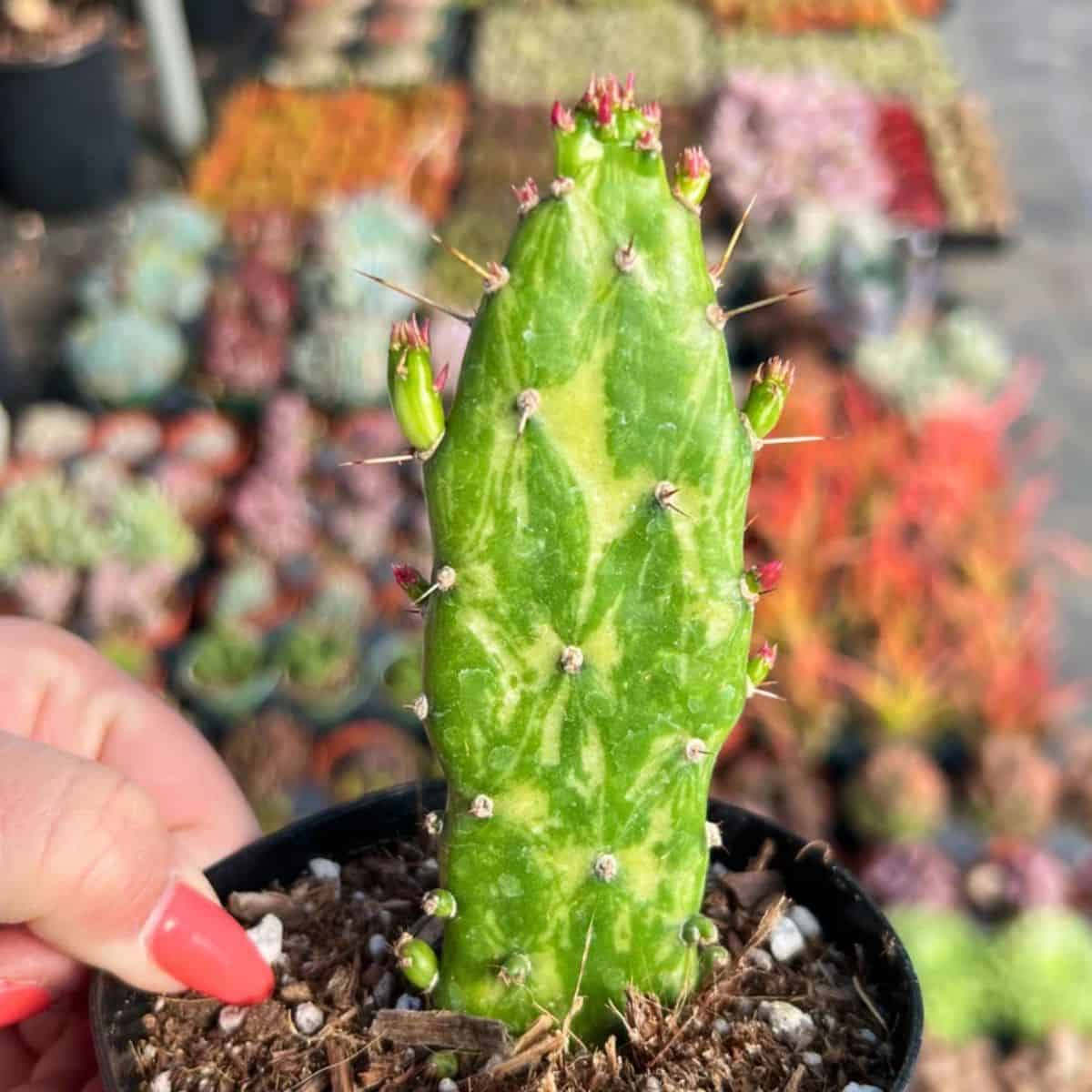
Buy it from:
| Maximum Height: | Up to 12 feet |
| Maximum Width: | Over 6 feet if not in a pot |
| Watering Needs: | Supplemental water during the dry season when established; water bi-weekly until established. |
| Soil Needs: | Well-draining soil (preferably sandy) |
| Light Needs: | Full sun to partial shade |
| Hardiness Zone(s): | Zone 9 and up |
| Bloom Color: | yellow |
| Leaf Type: | Column-like pads |
| Spine Type: | Singular spines, roughly an inch. |
I am quite partial to this species, as the non-Maverick hybrid is in my personal collection! The beautiful and oblong pads have gorgeous random variegation. The flowers are an entrancing yellow, although mine is still too young to bloom. They branch off easily, and their spines grow much larger as they get older. Be ready to enjoy this species year-round with its stunning colors!
7. Opuntia sulphurea
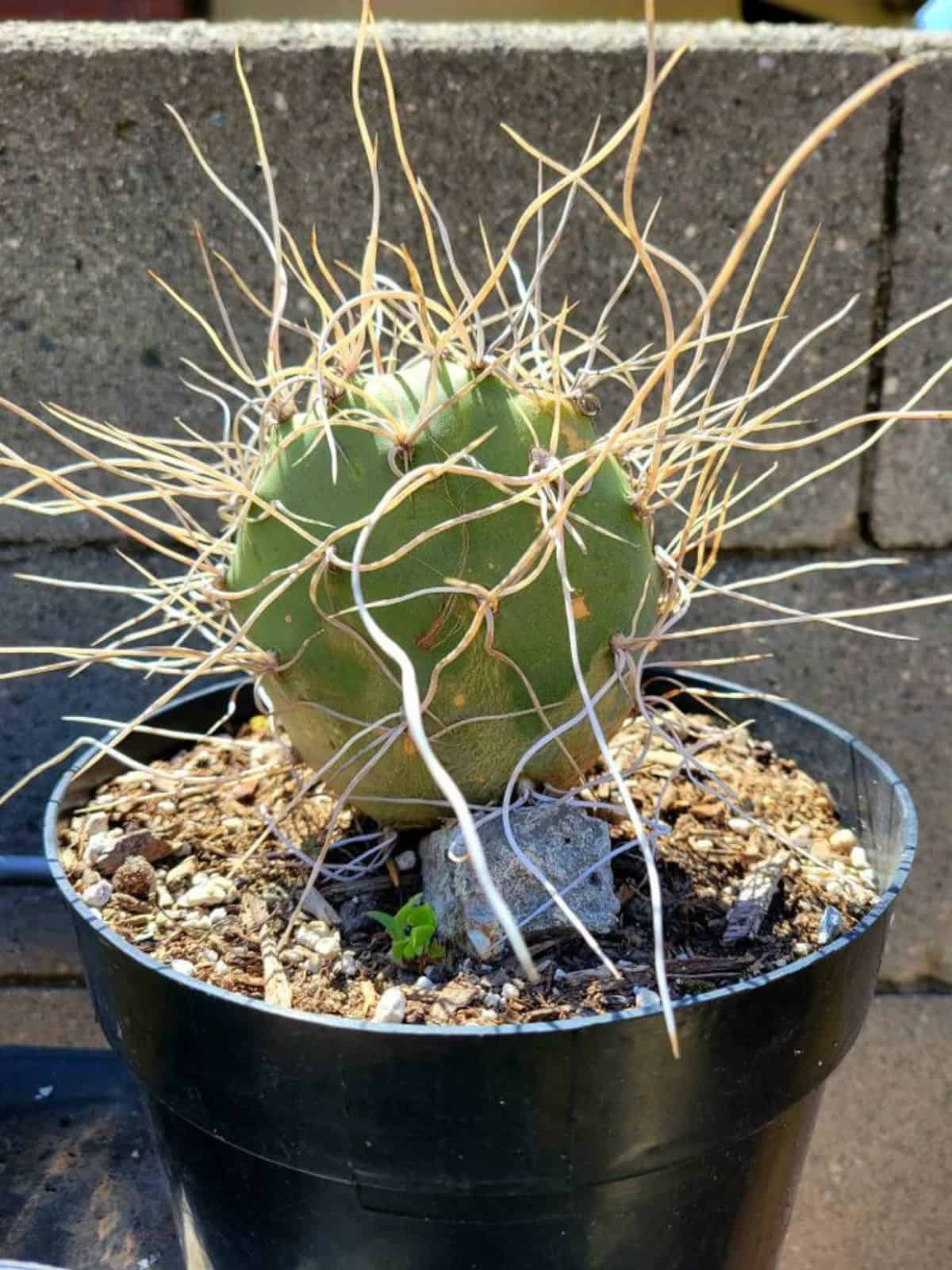
Buy it from:
| Maximum Height: | Up to 16 inches |
| Maximum Width: | Up to 7 feet |
| Watering Needs: | Supplemental water during the dry season when established; water bi-weekly until established. |
| Soil Needs: | Well-draining soil (preferably sandy) |
| Light Needs: | Full sun to partial shade |
| Hardiness Zone(s): | Zone 9 and up |
| Bloom Color: | Yellow |
| Leaf Type: | Thick pads with an oval shape; some undulation along the edges may be present. |
| Spine Type: | Stiff and wavy, up to an inch in length |
A low and slow grower, O. sulphurea is an attractive species with unique spines and a very rare type of undulation that occurs along the edges. Keep in mind that this is not a crested species, and the undulations follow the areoles. As this species forms a mat of dark green pads, the white and waving spines seem to connect the entire mat!
8. Opuntia erinacea ursine
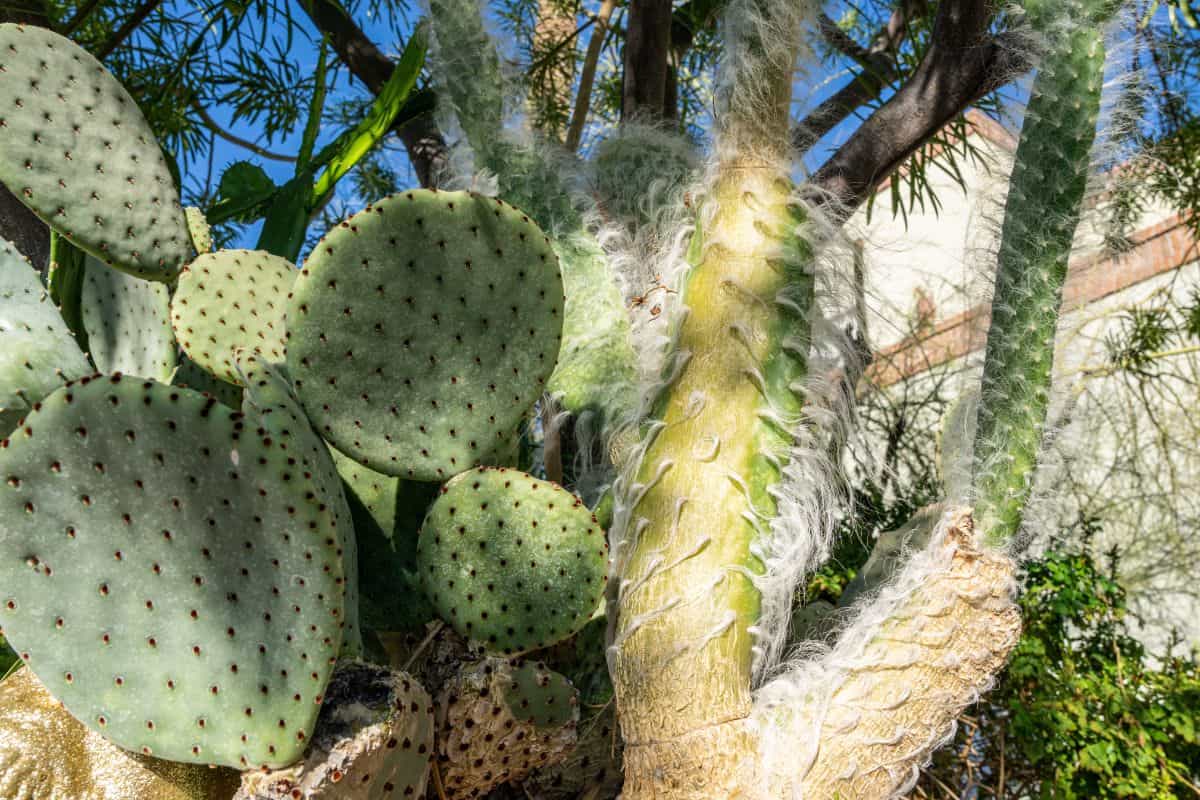
| Maximum Height: | Up to 2 feet |
| Maximum Width: | Up to 10 feet |
| Watering Needs: | Supplemental water during the dry season when established; water bi-weekly until established. |
| Soil Needs: | Well-draining soil (preferably sandy) |
| Light Needs: | Full sun to partial shade |
| Hardiness Zone(s): | Zone 9 and up |
| Bloom Color: | Light yellow |
| Leaf Type: | Columnar, thin paddles |
| Spine Type: | Thin hairy spines that obscure the pads of the cactus |
Another bear named cactus (ursine in Latin relates to bears) this species is known as Snow Prickly Pear and Angel Wings. Thin spines and hairy glochids trail along the oblong pads and cover them in snowy ‘hair.’ While they don’t get very tall, they can be used as a form of white hedge to protect smaller species of cacti
9. Cinnamon Cactus
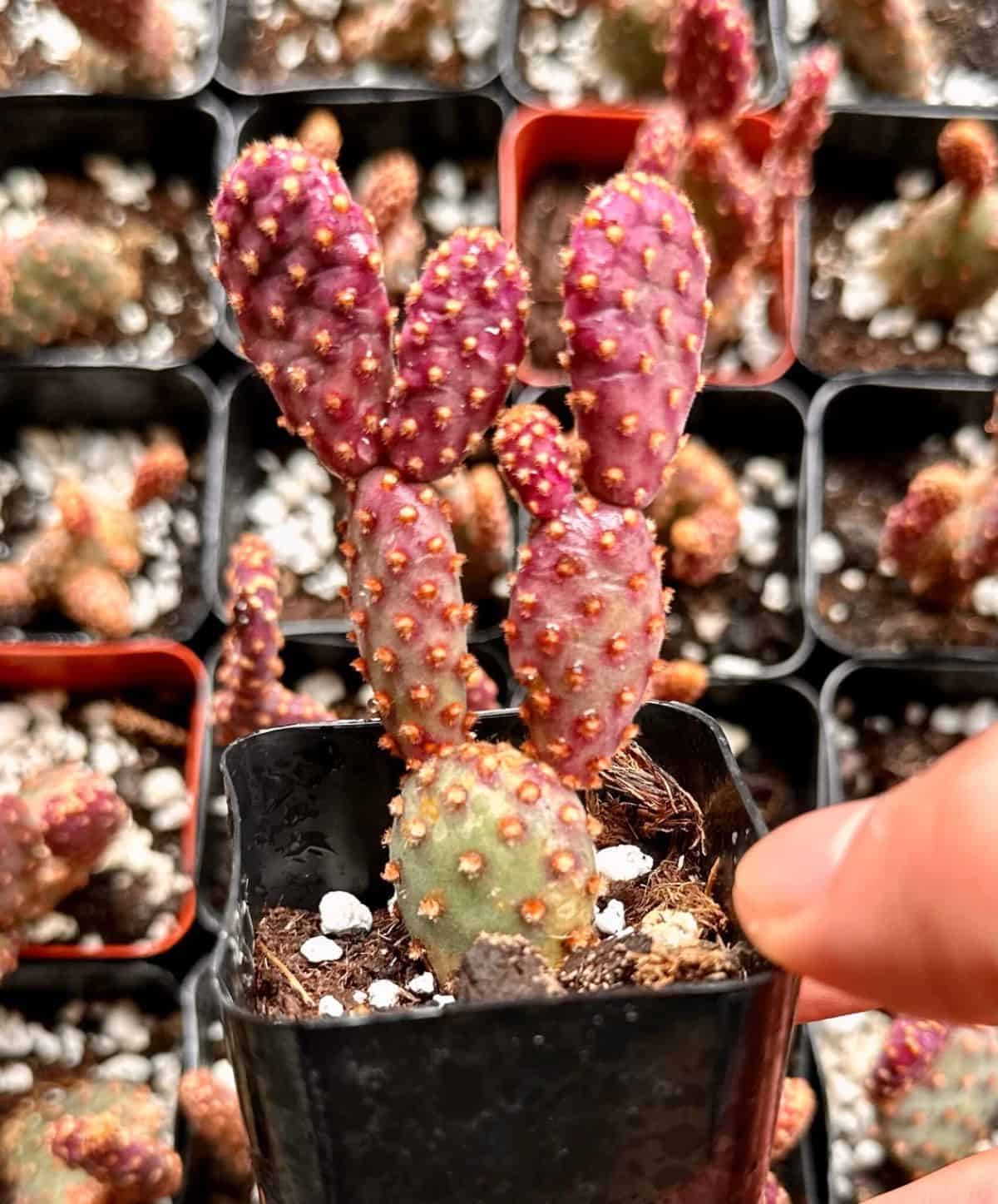
Buy it from:
| Maximum Height: | Up to 10 inches |
| Maximum Width: | Will grow to fit the pot |
| Watering Needs: | Supplemental water during the dry season when established; water bi-weekly until established. |
| Soil Needs: | Well-draining soil (preferably sandy) |
| Light Needs: | Full sun to partial shade |
| Hardiness Zone(s): | Zone 9 and up |
| Bloom Color: | Yellow |
| Leaf Type: | Full and shaped like a prickly pear pad |
| Spine Type: | Small cinnamon, colored spikes |
Another tiny titan, the gorgeous Cinnamon cactus, or Opuntia rufida minima, has thicker pads that are home to cinnamon-colored glochids. The areoles that cover the pads are packed tightly enough that this species can take on an orangey haze from a distance.
10. Opuntia engelmannii
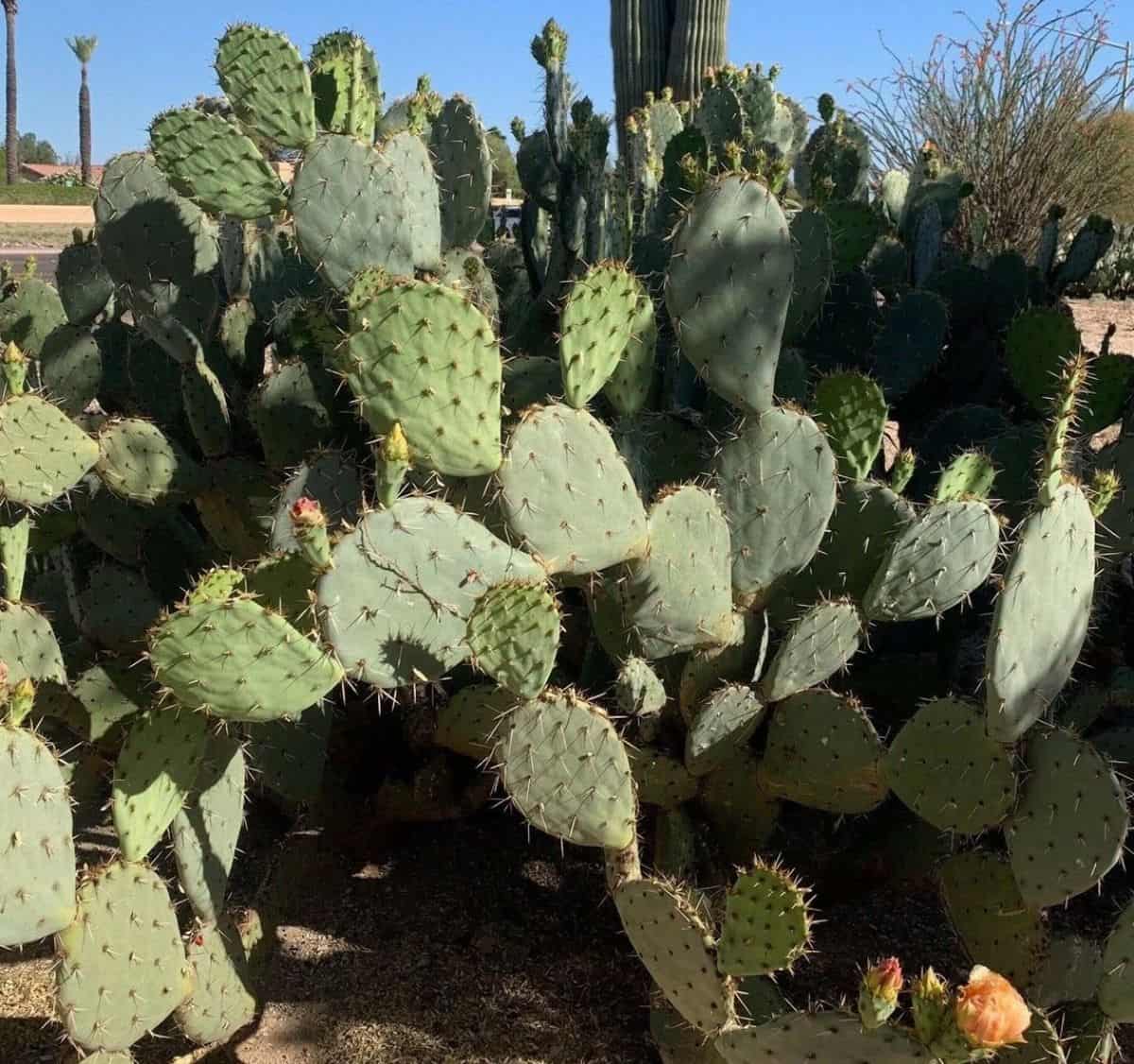
Buy it from:
| Maximum Height: | Up to 5 feet |
| Maximum Width: | Up to 30 feet |
| Watering Needs: | Supplemental water during the dry season when established; water bi-weekly until established. |
| Soil Needs: | Well-draining soil (preferably sandy) |
| Light Needs: | Full sun to partial shade |
| Hardiness Zone(s): | Zone 8 and up |
| Bloom Color: | Yellow |
| Leaf Type: | Roughly 11 x 6 inches and shaped like an egg |
| Spine Type: | White or gray and up to 2 inches long |
If you’ve been to Texas and driven through the vast stretches of land, then you have seen many a mountain of this species. It grows into massive clumps when not controlled. While a single plant can grow as tall as five feet, many Prickly Pear mounds end up being much taller. The dead trunks of older O. engelmannii continue to pile up underneath new growth. Some of the largest mounds can get well over ten feet tall.
11. Opuntia consolea rubescens
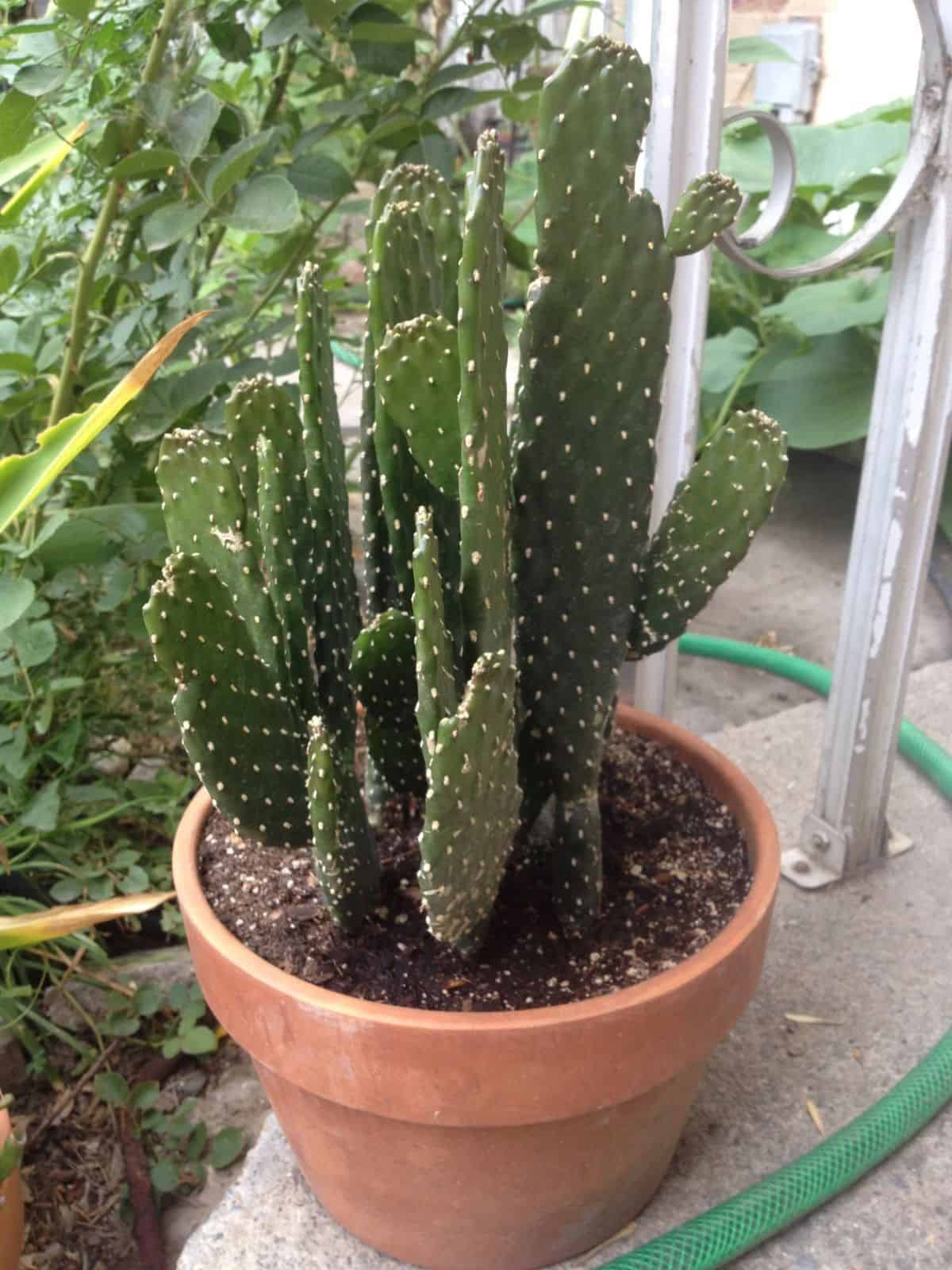
Buy it from:
| Maximum Height: | Up to 20 feet |
| Maximum Width: | Varies |
| Watering Needs: | Supplemental water during the dry season when established; water bi-weekly until established. |
| Soil Needs: | Well-draining soil (preferably sandy) |
| Light Needs: | Full sun to partial shade |
| Hardiness Zone(s): | Zone 9 and up |
| Bloom Color: | Bright pink to an intense red |
| Leaf Type: | Silver green and very flat oblong pads that can get up to 20 inches long |
| Spine Type: | Nearly spineless but can have some spines up to one inch long |
Roadkill cactus. What a name, right? It doesn’t stink or smell odd when blooming, but it is instead named for the way that the areoles look like tire tracks along each pad. It is a generally spineless species, and the flower color can vary. However, the most prominent color especially when grown outside, is an intense red.
12. Opuntia subulata
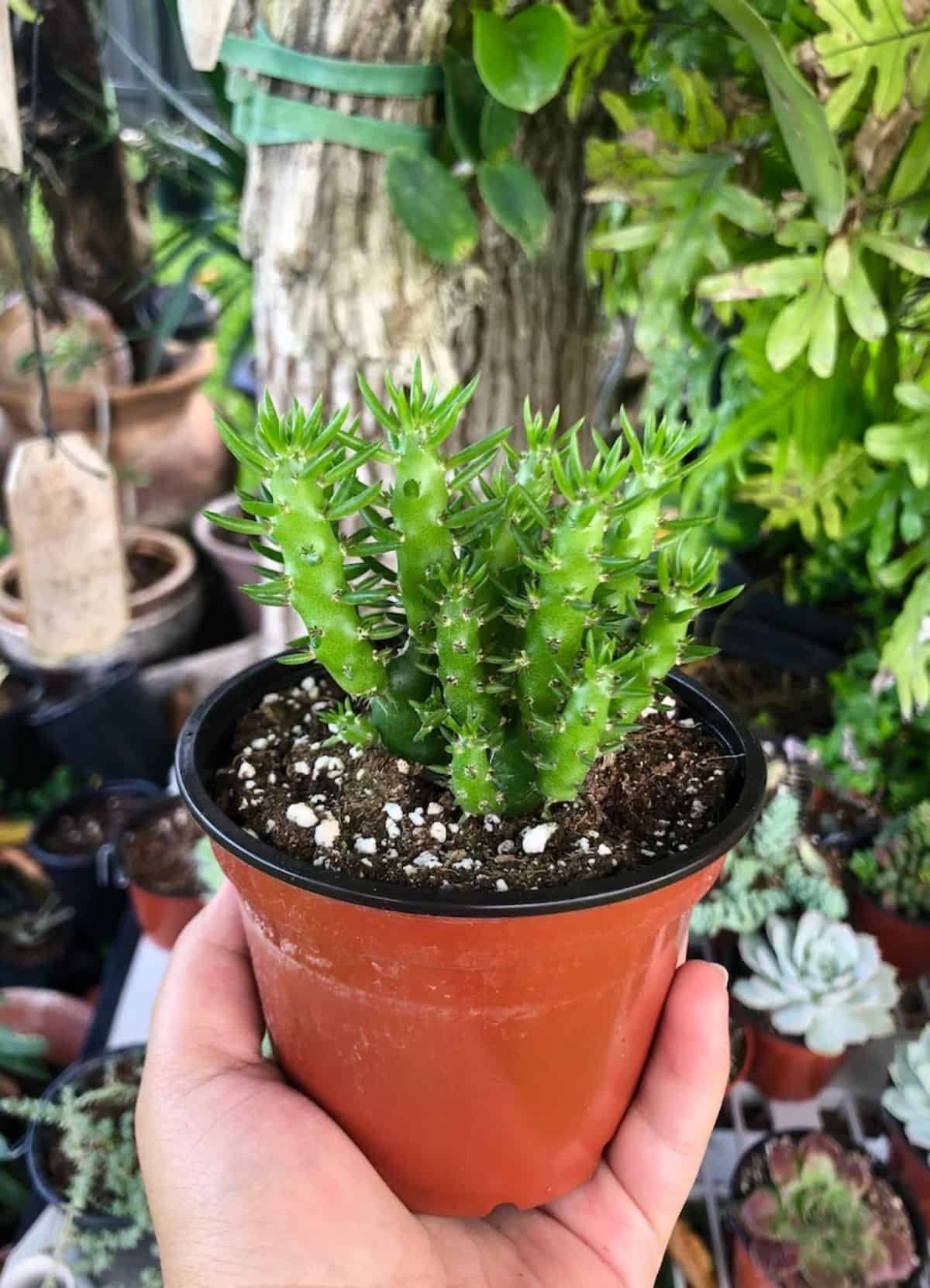
Buy it from:
| Maximum Height: | Up to 13 feet in its natural habitat |
| Maximum Width: | Not found |
| Watering Needs: | Supplemental water during the dry season when established; water bi-weekly until established. |
| Soil Needs: | Well-draining soil (preferably sandy) |
| Light Needs: | Full sun to partial shade |
| Hardiness Zone(s): | Zone 9 and up |
| Bloom Color: | Orange to dark reddish burgundy |
| Leaf Type: | Thin awl-shaped leaves with a short spine at the end. Can get up to 5 inches long |
| Spine Type: | Short spines along the stem |
This opuntia has gone through a few name changes. At first, it was called O. subulata but it has gone through a recent change to Austrocylindropuntia subuluata. The common name that you’ll see most often is Eve’s Needle, and the less common name is Gumby/Gumbi. It is a more stem-based species with leaves that are sharp and pointed (they also don’t propagate well from the small leaves).
13. Boxing Glove Opuntia
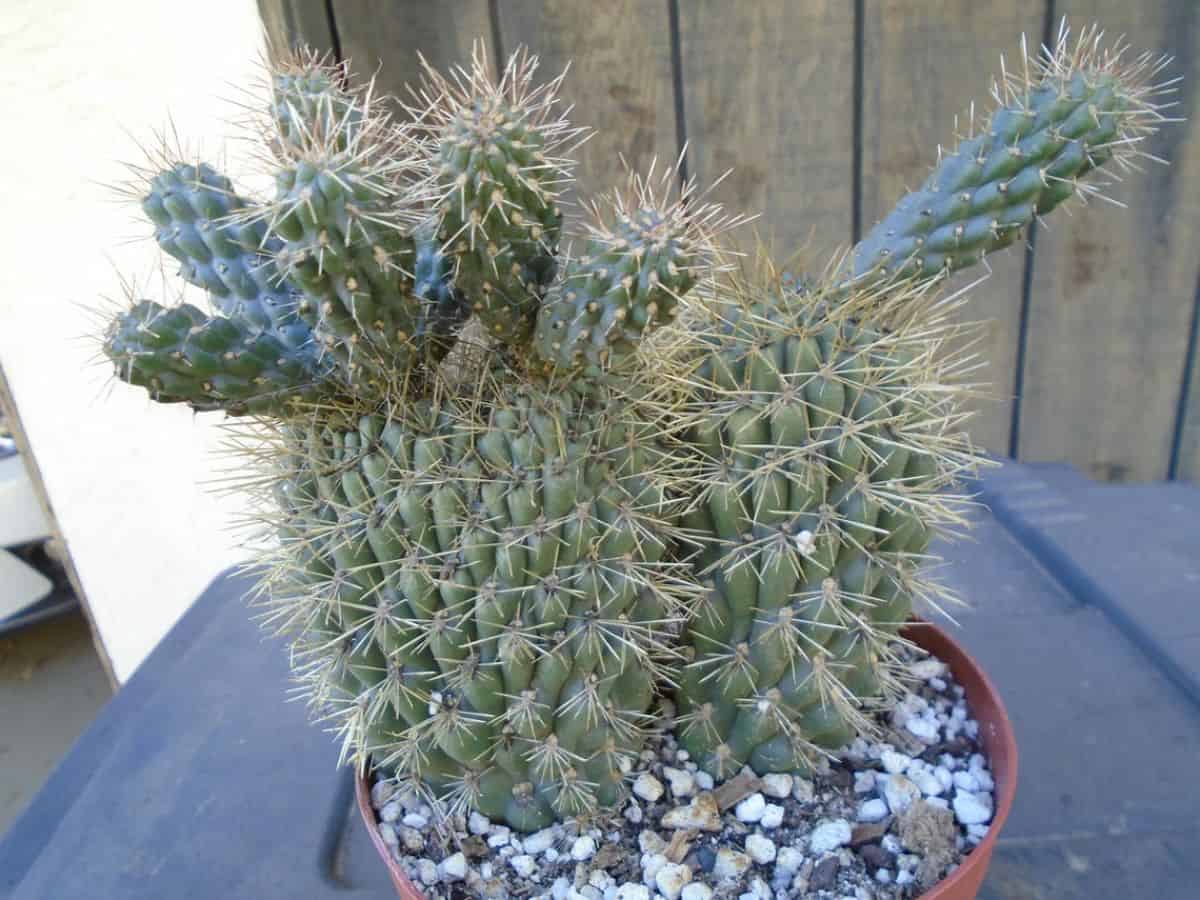
Buy it from:
| Maximum Height: | Up to 13 feet |
| Maximum Width: | Up to 7 feet |
| Watering Needs: | Supplemental water during the dry season when established; water bi-weekly until established. |
| Soil Needs: | Well-draining soil (preferably sandy) |
| Light Needs: | Full sun to partial shade |
| Hardiness Zone(s): | Zone 8 and up |
| Bloom Color: | White and pink |
| Leaf Type: | Short one-inch leaves when young |
| Spine Type: | Short spines that cover the branches and fruiting bodies. Handle with great caution: the spines have hooks on them, much like glochids |
Opuntia fulgida is definitely a species to avoid unless you are ready to deal with consequences. Boxing Glove is considered a jumping cholla. Hikers and collectors alike have described removing the spines and fruits from this plant as one of the most painful experiences they have had. If not handled with care, the hook-coated spines easily dig into skin and clothes.
14. Red Buttons Opuntia
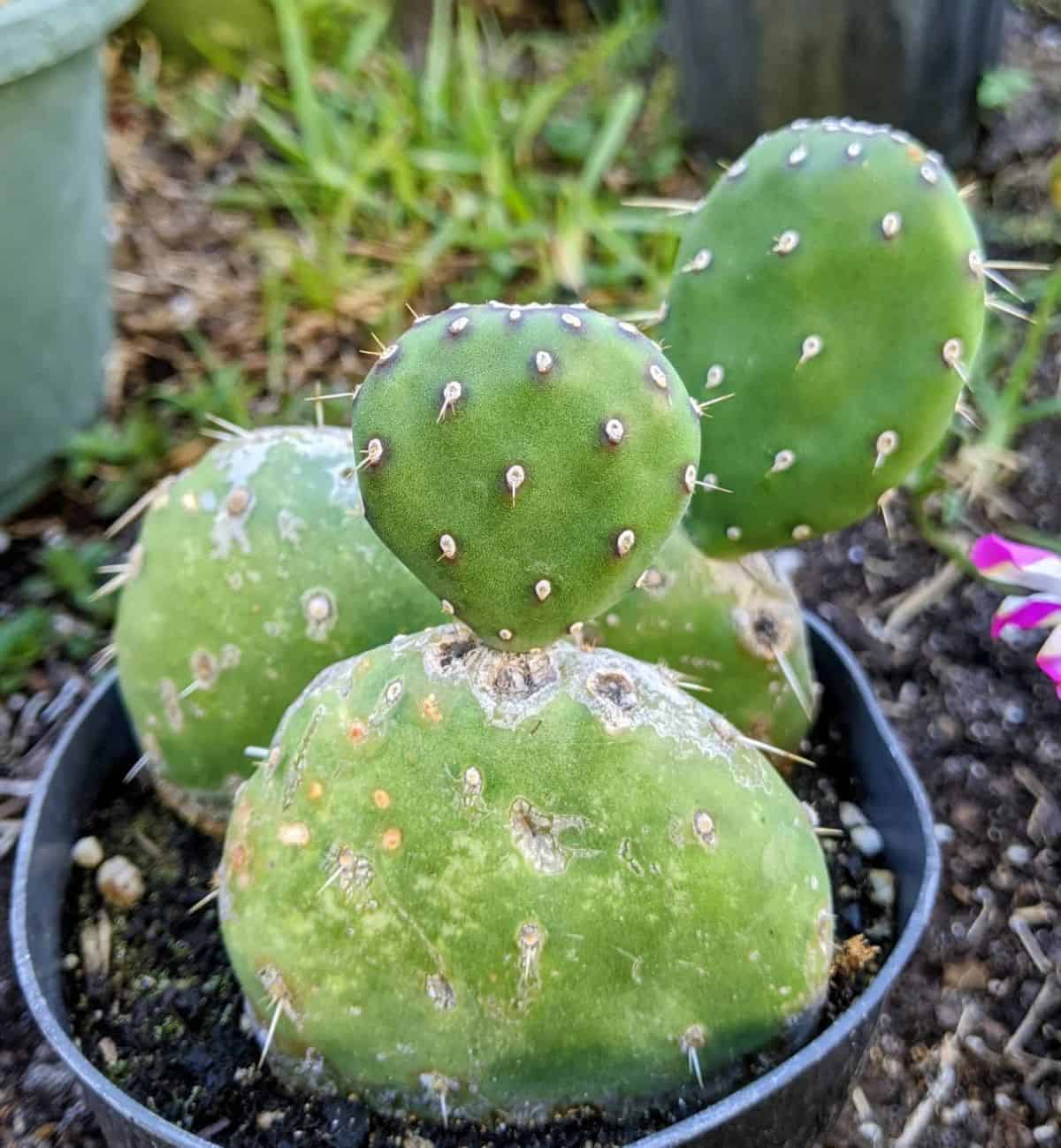
Buy it from:
| Maximum Height: | Up to 5 feet |
| Maximum Width: | Up to 1 foot |
| Watering Needs: | Supplemental water during the dry season when established; water bi-weekly until established. |
| Soil Needs: | Well-draining soil (preferably sandy) |
| Light Needs: | Full sun to partial shade |
| Hardiness Zone(s): | Zone 10 and up |
| Bloom Color: | Red to red-orange |
| Leaf Type: | Thickened paddle |
| Spine Type: | Small and rarely occurring |
Opuntia quintensis is a tall grower like other tree-type species. The way that it got its name was from the very small red blooms that occur along the edges of the pads. They look like tiny little buttons! Most opuntias are thinner than others; however, this species is even more special because the pads are much thicker than other opuntia species.
15. Opuntia falcata
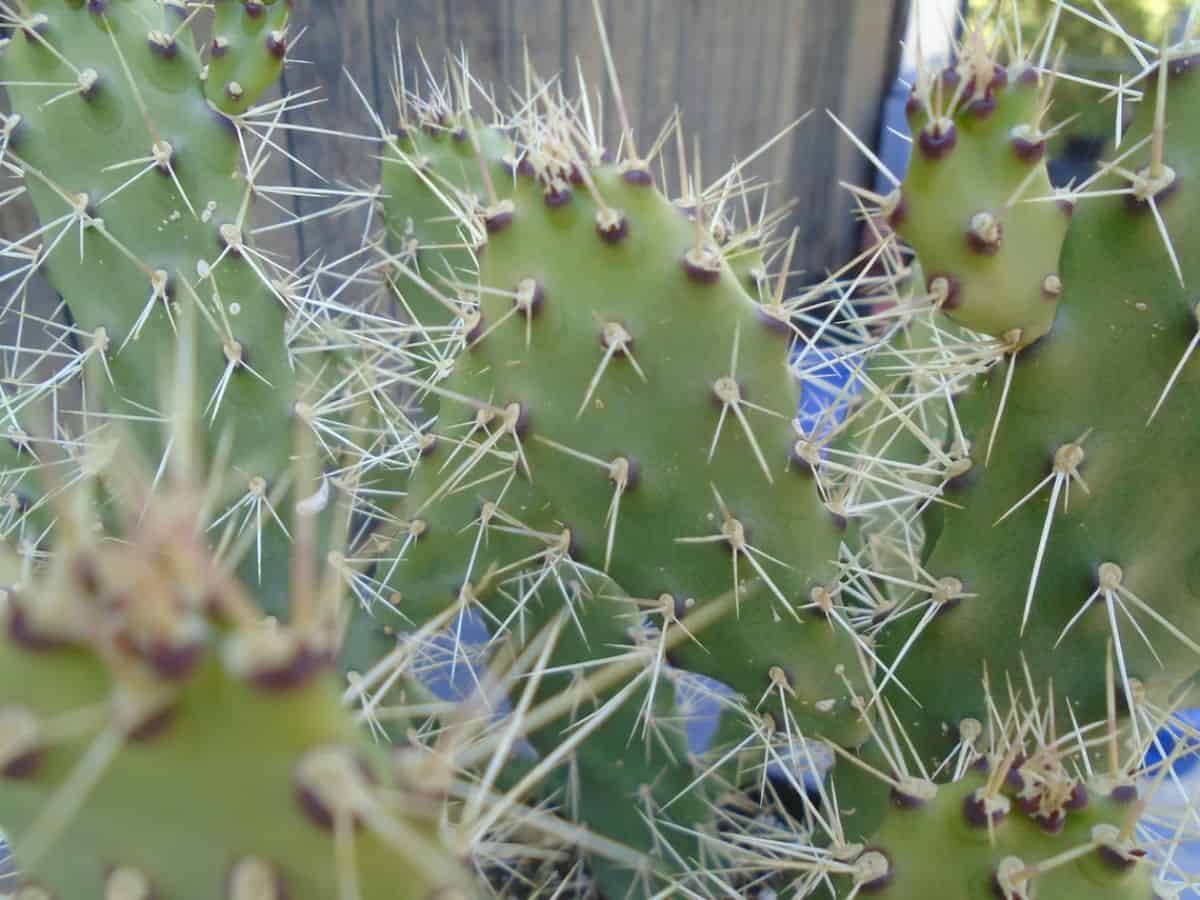
Buy it from:
| Maximum Height: | Up to 8 feet |
| Maximum Width: | Up to 6 feet |
| Watering Needs: | Supplemental water during the dry season when established; water bi-weekly until established. |
| Soil Needs: | Well-draining soil (preferably sandy) |
| Light Needs: | Full sun to partial shade |
| Hardiness Zone(s): | Zone 9 and up |
| Bloom Color: | Deep red-orange |
| Leaf Type: | Elongated pads |
| Spine Type: | Present on areoles; however, there are few areoles. |
Also called tree opuntia or Saguaro Opuntia, this species isn’t to be confused with a saguaro cactus. It is a taller species that has elongated pads that seem to be shaped more like loaves of French bread. It is another practically spineless species, but it should still be handled with care as there are some spines along the terminal edges.
16. Opuntia macrocentra
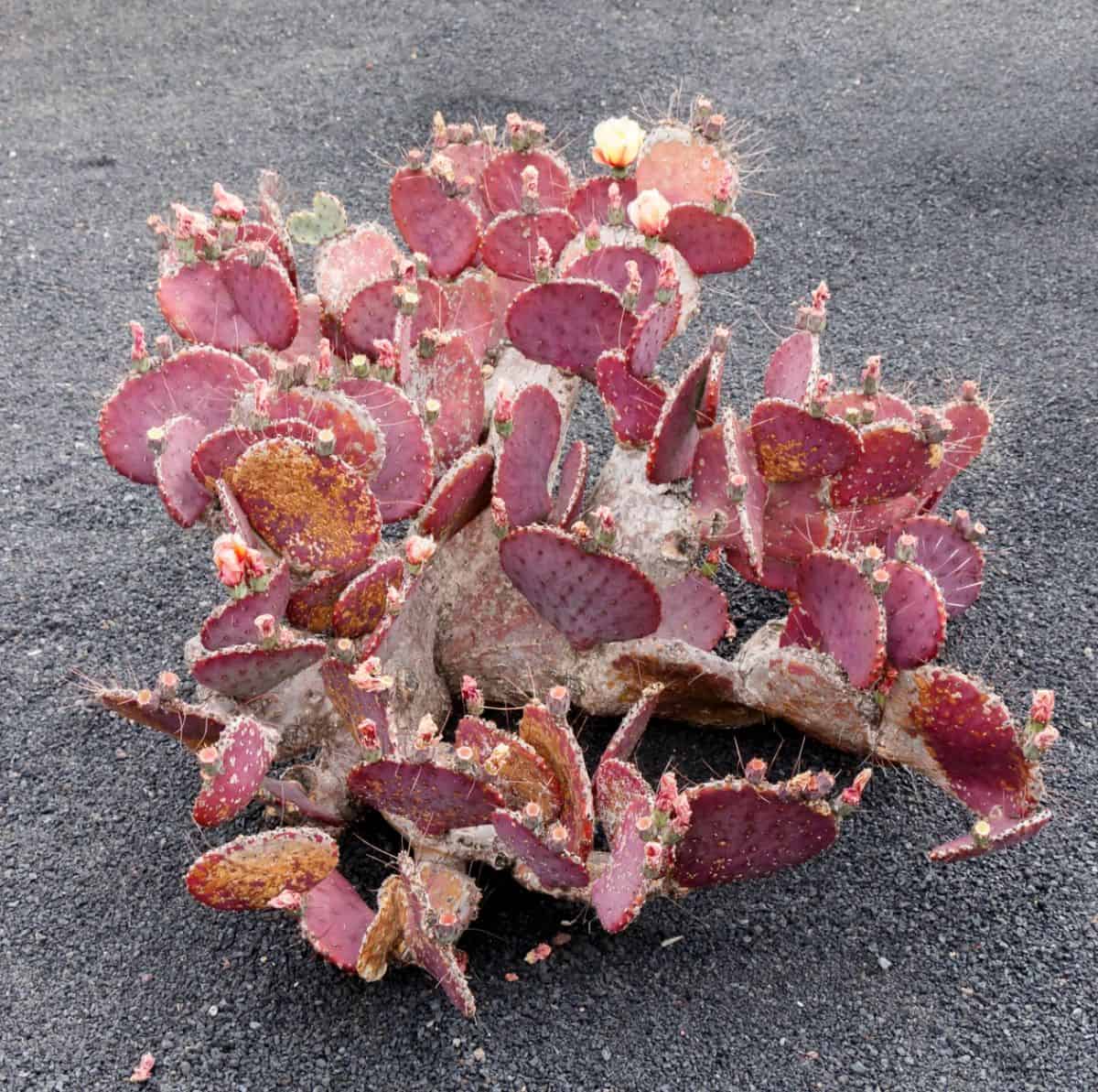
Buy it from:
| Maximum Height: | Up to 4 feet |
| Maximum Width: | Up to 10 feet |
| Watering Needs: | Supplemental water during the dry season when established; water bi-weekly until established. |
| Soil Needs: | Well-draining soil (preferably sandy) |
| Light Needs: | Full sun to partial shade |
| Hardiness Zone(s): | Zone 6 and up |
| Bloom Color: | Yellow with bright red centers |
| Leaf Type: | Shaped like a traditional prickly pear pad (egg-like with a pointed base) |
| Spine Type: | Dark black and several inches in length |
The Purple Prickly Pear, Sapphire Wave, or my favorite opuntia, this species goes by a few names. It is one of the few species that takes on a more purple color. These species are O. chlorotica, O. gosseliniana, O. santa rita, and a hybrid called Amethyst Wave. This species sets itself apart with its dark black spines that add an element of gothic danger to the paddles. No … really, the spines are incredibly sharp!
17. Aaron’s Beard Prickly Pear
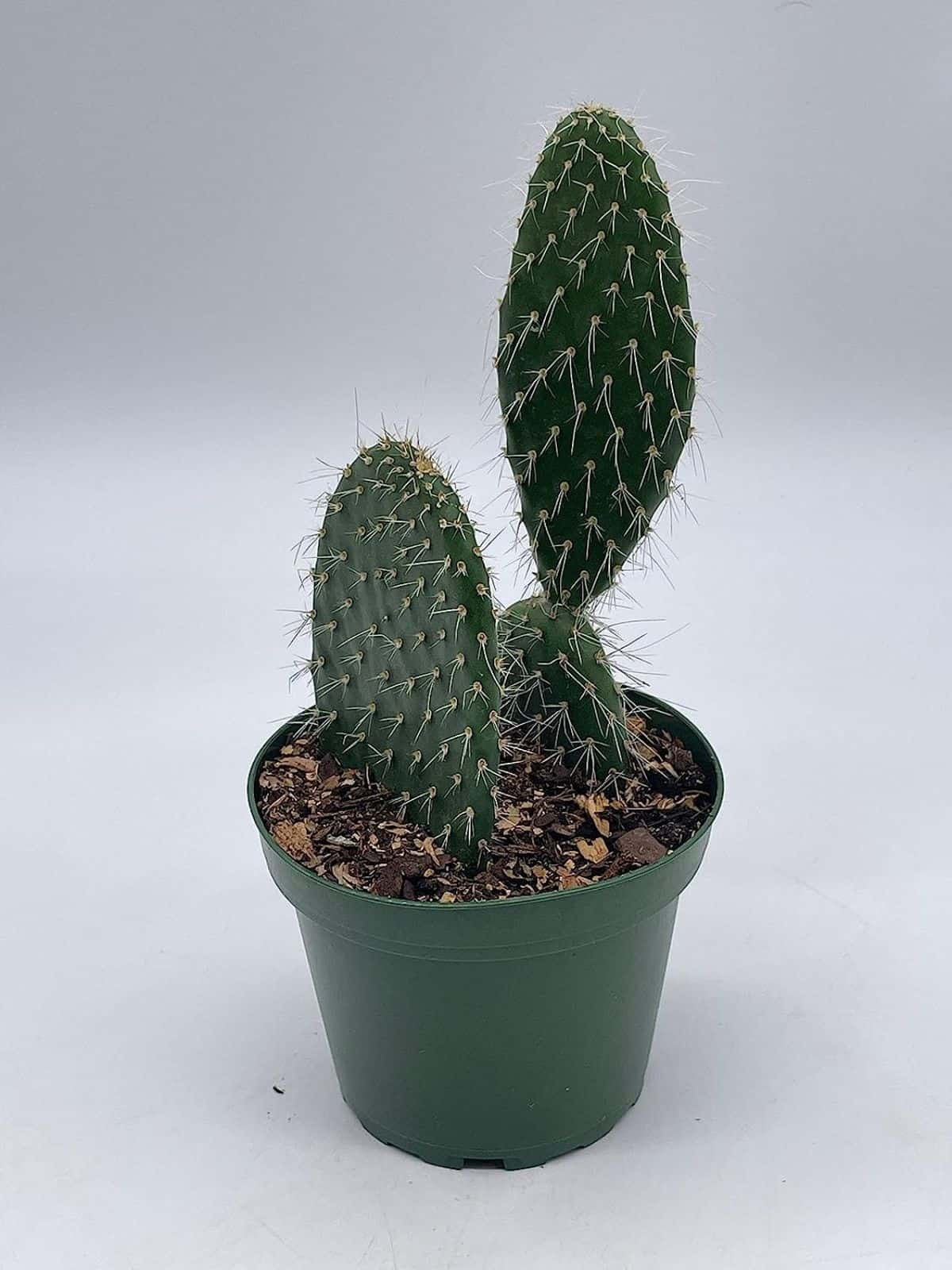
Buy it from:
| Maximum Height: | Up to 16 feet |
| Maximum Width: | Depends on the support provided for the branches |
| Watering Needs: | Supplemental water during the dry season when established; water bi-weekly until established. |
| Soil Needs: | Well-draining soil (preferably sandy) |
| Light Needs: | Full sun to partial shade |
| Hardiness Zone(s): | Zone 6 and up |
| Bloom Color: | Yellow with greenish center |
| Leaf Type: | More oblong compared to the regular egg-like shape of most pads |
| Spine Type: | Short spines primarily at the terminal end of the pads on older plants |
An invasive species in Florida, Opuntia leucotricha is a tall tree-like species that spreads very quickly. Despite the height of the plant, the most gorgeous element is the flowers. Most opuntia doesn’t have greenish flowers; however, this species has flowers with lime-green centers. Be careful of the short spines, as they can easily get lodged in unsuspecting hands, legs, arms, or other areas.
18. Opuntia Amethyst Wave

Buy it from:
| Maximum Height: | Up to 11 feet |
| Maximum Width: | Not found |
| Watering Needs: | Supplemental water during the dry season when established; water bi-weekly until established. |
| Soil Needs: | Well-draining soil (preferably sandy) |
| Light Needs: | Full sun to partial shade |
| Hardiness Zone(s): | Zone 6 and up |
| Bloom Color: | Rose pink coloration |
| Leaf Type: | General pad shape, 3-4 inches across at the widest point |
| Spine Type: | Roughly an inch long and varies from gray to black coloration. |
Also known as the dwarf Santa Rita, Amethyst Wave is a species that tends to stay small but will grow taller in the right conditions (generally outside). It is a notoriously slow grower and has pads that are nearly half the size of the pads from the larger O. santa-rita. Most Amethyst Wave data recorded has been for species grown in pots rather than in the ground. Considering how long it takes for this species to grow, it may be some time before we see how wide it can get.
19. Opuntia invicta
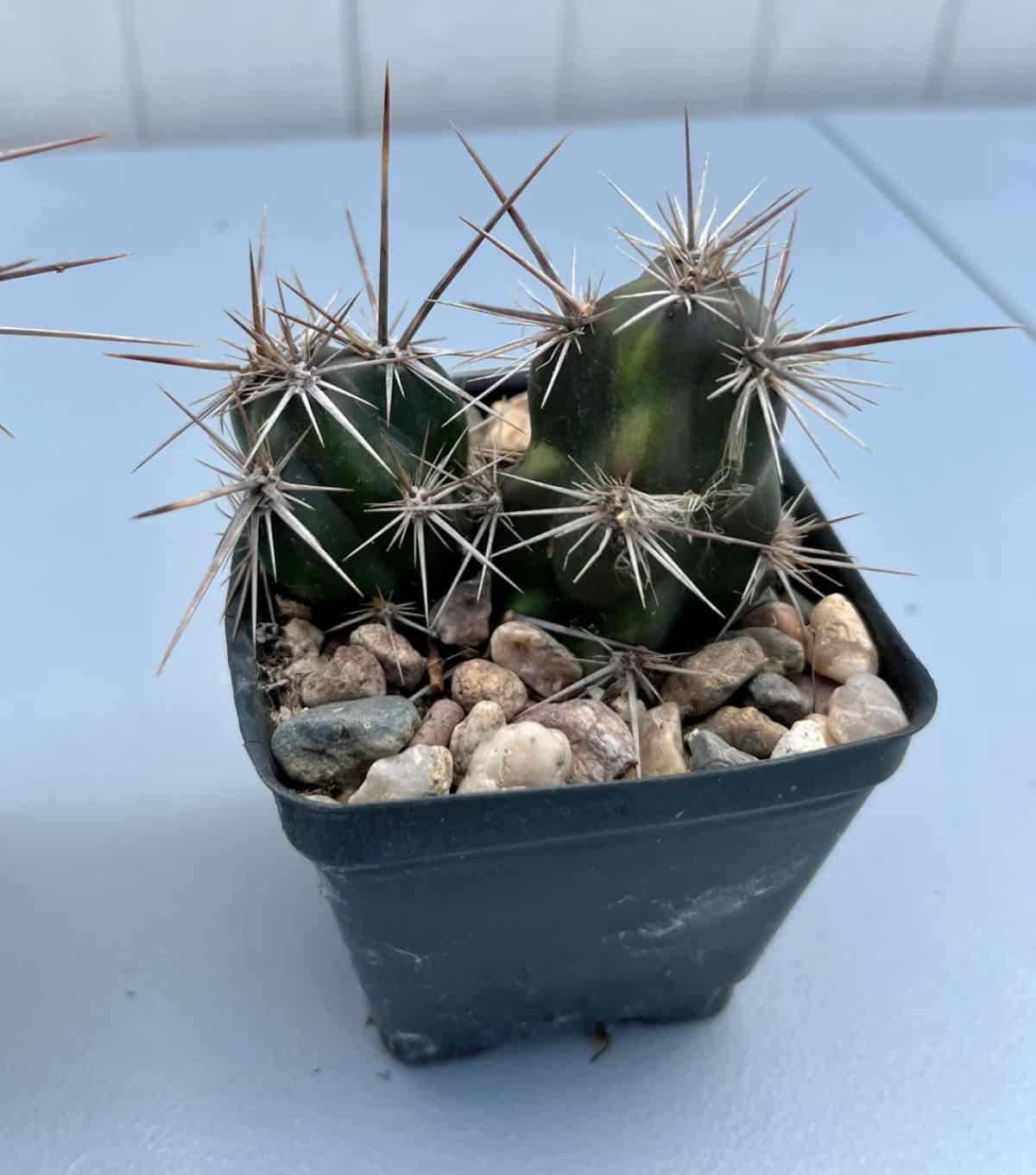
Buy it from:
| Maximum Height: | Up to 2 feet |
| Maximum Width: | Up to 6.5 feet |
| Watering Needs: | Supplemental water during the dry season when established; water bi-weekly until established. |
| Soil Needs: | Well-draining soil (preferably sandy) |
| Light Needs: | Full sun to partial shade |
| Hardiness Zone(s): | Zone 7 and up |
| Bloom Color: | Yellow |
| Leaf Type: | Smaller pads that take on a reddish tone |
| Spine Type: | Up to 2 inches in length and shaped like daggers. Some red coloration at the base of the spines. |
If you want a company deterring species that form large mats of spiky death traps, then look no further. This shin-hitting species has some of the largest and most intimidating types of spines to look at or walk by. There is a central spine that points directly outward, with several that radiate outward from the same areole. Beautiful to look at, but definitely not fun to handle!
20. Opuntia cochenillifera variegata
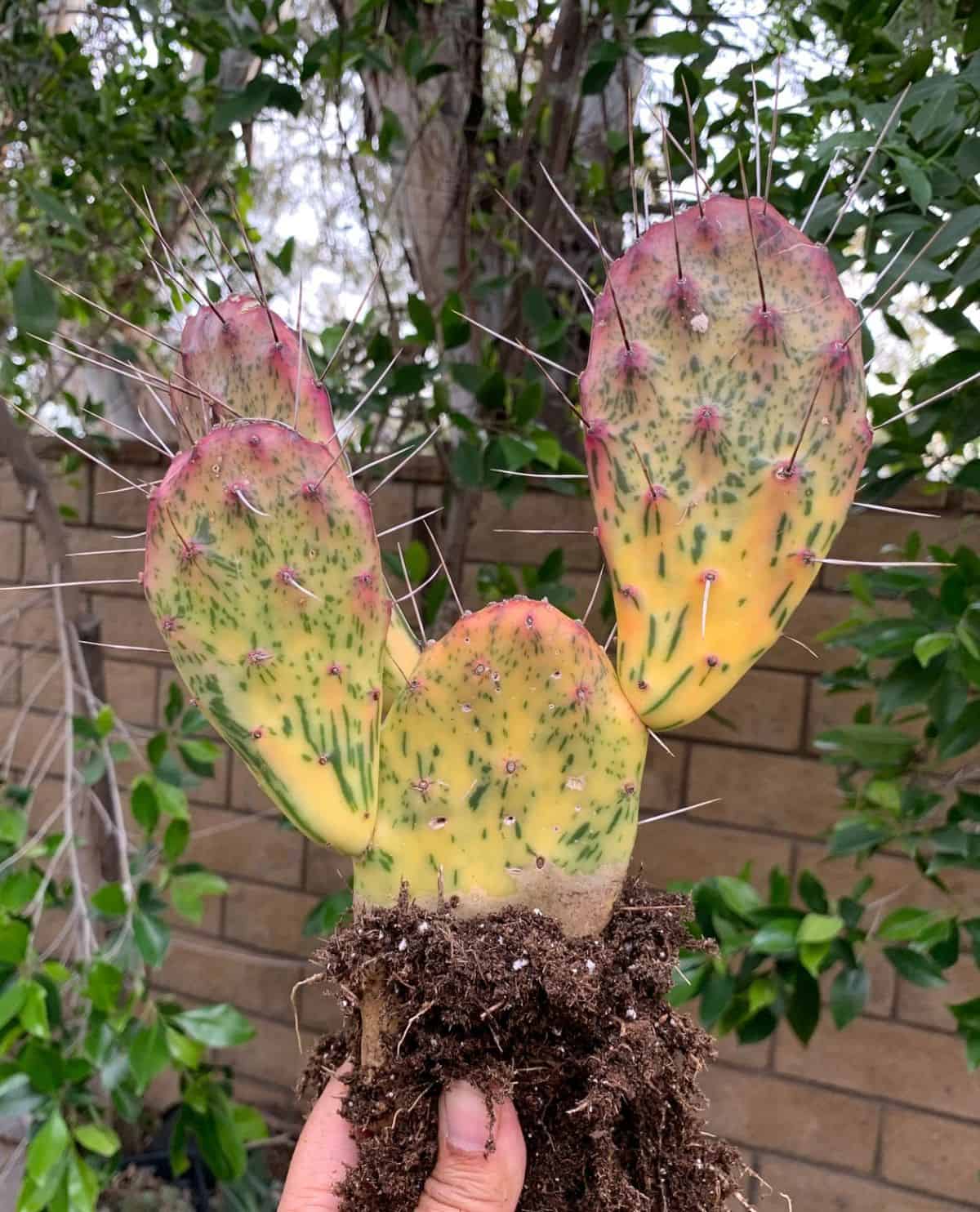
Buy it from:
| Maximum Height: | Up to 8 feet |
| Maximum Width: | Depends on care |
| Watering Needs: | Supplemental water during the dry season when established; water bi-weekly until established. |
| Soil Needs: | Well-draining soil (preferably sandy) |
| Light Needs: | Full sun to partial shade |
| Hardiness Zone(s): | Zone 9 and up |
| Bloom Color: | Magenta |
| Leaf Type: | Oblong pads |
| Spine Type: | Primarily spineless through selective breeding |
The Starburst, or variegated O. cochenillifera is hard to find. The base of the leaves tends to start off reddish in color and fade to a bright variegated yellow. The base species for this variant is actually one of the most widely used species of opuntia. It is a major food source for many people, and because of its spineless nature, it is also used to grow cochineals which can be used as a dark purple dye.

